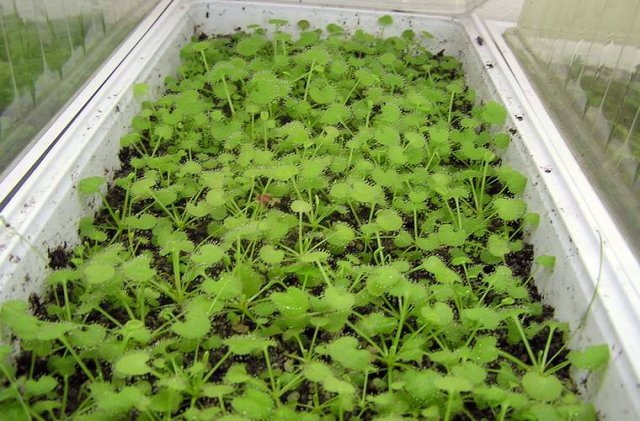Toto je starší verze dokumentu!
HtG
How to Grow Experiment (HtG)
Finding out the best conditions for carnivorous plants cultivation
The goal of this experiment is to get information about possibilities on how to succesfully grow different species of carnivorous plants mostly under domestic conditions. In the pilot year there are easy species chosen to grow for a smooth start. In the following years it will be possible to improve skills and step up to more difficult species.
Teams
More Informations
The first step is to establish groups. Each group will grow one of the chosen species and it will be lead by the Group Leader (GL). Group Leader will coordinate the experiment, distribute work tasks, answer for the experiment result and prepare the final report to be published in society channels (Chramst!, Trifid).
Each group will get 100 acclimatized plants of the chosen species and the GL will distribute them and determine the cultivation conditions. These conditions will be a general guide. There will be different substrate, temperature, light, watering etc. Other modifications are up to the GL and group decision. Tested plants will stay in the group property, they can be used on Darwiniana's exhibitions. Plants are not meant for commercial purposes, just to give away or to exchange is allowed.
The ideal is to establish the group around the GL's place of residence but as there are not often the right conditions (e.g. people with cold showcase) this is not an essential. One grower can be a member of more than one group. It is not requirement that members of the group be a member of the Darwiniana Society. A member of a group can be for example in a scientific circle of a school.
Start of the project – September 2008
First phase September 2008 – April 2009: plant propagation in „in vitro“ culture
Second phase May 2009 – September 2009: plant growing in defined conditions (summer period)
Third phase September 2009 – April 2010: plants growing in defined conditions (winter period)
In September 2008 the first setting on multiplied cultivation medium was realized. The second setting will be done in November and December. In this time the corrections of the medium will be made and the right procedure will be chosen regarding the results of first setting to get the required number of plants in February. During February to April will run the acclimatization and root making. Everything will be photo documented and placed on each plants cards.
During this winter the groups will be established and the conditions for growers - members of groups will be chosen. The tables will be actualized. In May the plants will be sent to Group Leaders. After processed it, the GL will fill up the detailed starting information (like number of plants, lenght, number of leaves).
Finishing and evaluation of the second phase should be done till the end of August 2009 till the opening of Darwiniana exhibition where the plants of the teams could be presented. Then the next phase will help to specify the best wintering conditions. End of the first round is expected to be done in spring 2010.
Species of CP (Carnivorous Plants) and the GL (Group Leader)
| Dionaea muscipula South-West Giant | Markéta Aubrechtová |
| Drosera falconeri | Jiří Vaněk |
| Drosera burkeana | Jan Bronec |
| Drosera filiformis | Patrik Zákostelský |
| Drosera prolifera | Jana Rubešová |
| Drosera cistiflora | Adam Veleba |
| Nepenthes rafflesiana × ampularia | Tomáš Andrlík |
| Heliamphora minor | Petr Bílek |
| Sarracenia purpurea | Pavel Říčný |
| Pinguicula filifolia | Jan Novák |
General Conditions
Plants will be transported from in vitro cultivation to the substrate during February and till the end of April they will be acclimatized in high air humidity and with the 16/8 photoperiod under the 36 W fluorescent tube 35 cm distant from plant
Time period for experiments is defined by cultivation season from end of April till end of August and wintering season from September to next April. In table columns there will be stated always the starting status /x/ lenght of leaf, number of leaves etc. and behind the slash there will be status after the experiment end /y/. Values x and y will be the average of the number of tested pl
In the firs round /season 2009 - 2010/ will be the priority to get information about proper substrate. Cultivation will be running on generally recommended conditions. Other tests will be informative. In the next round /season/ the optimal substrate will be used and other values will be monitoring in detail.
After an agreement and closing the teams by Group Leaders then the tables for each species will be sent to fill them up regarding the cultivation possibilities of each team.
Everything is possible to discuss with the author of this project Michal Kouba at labflytrap@gmail.com .
